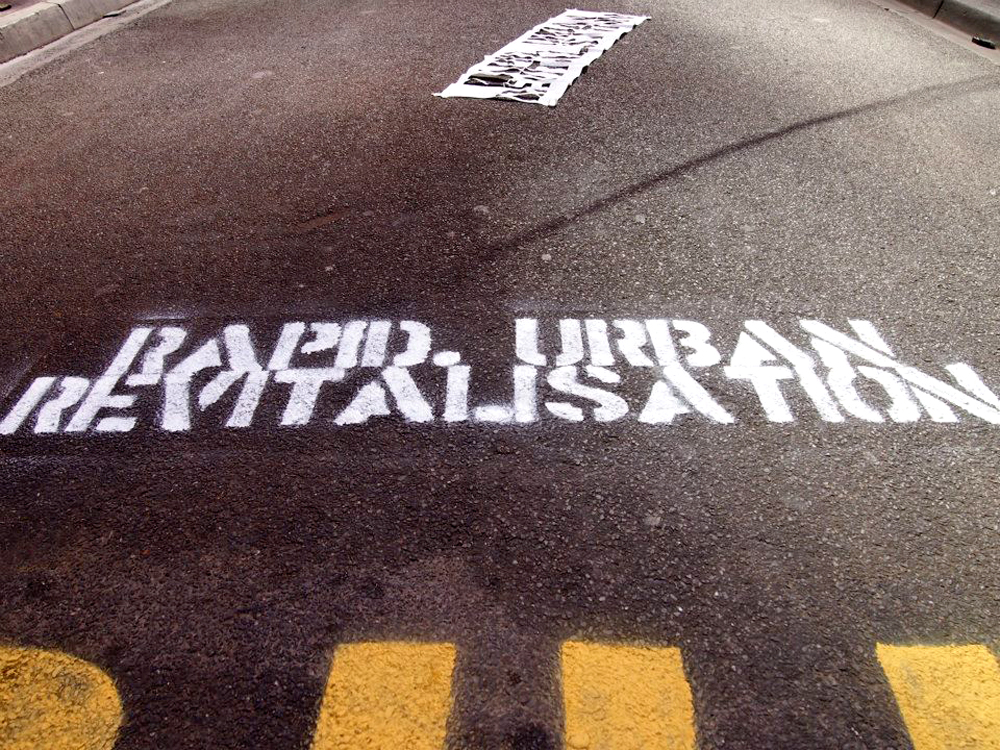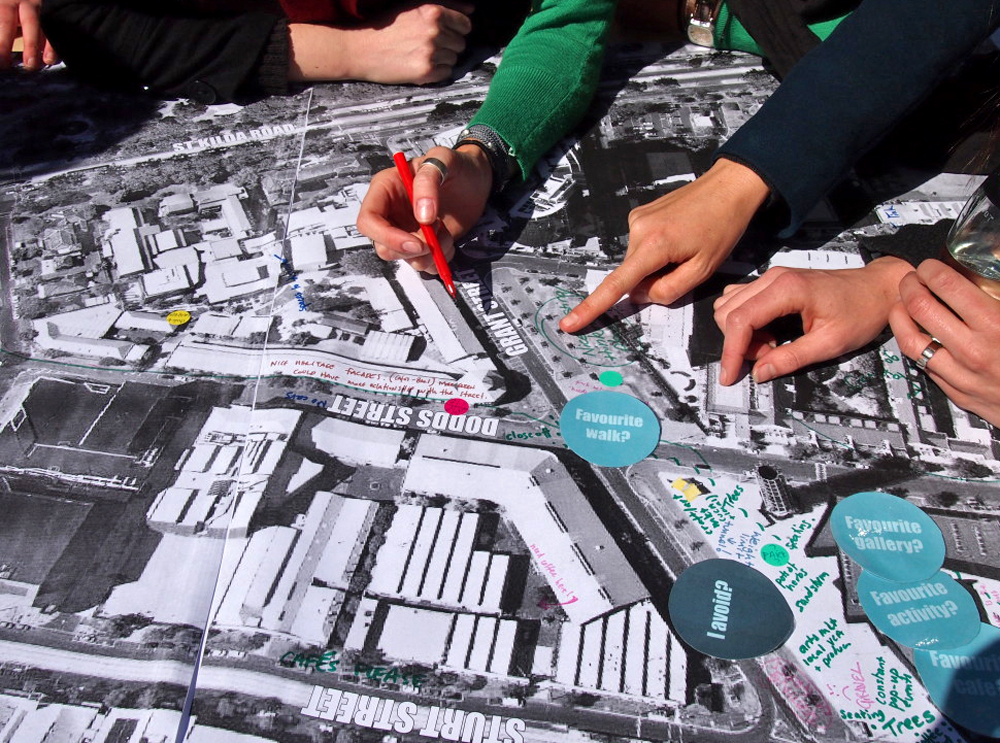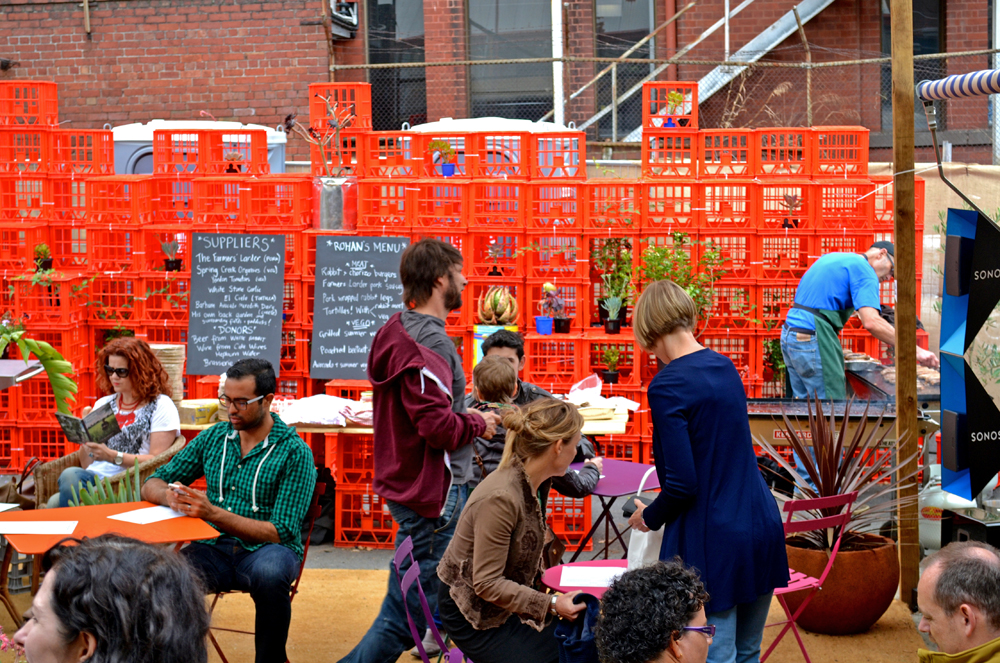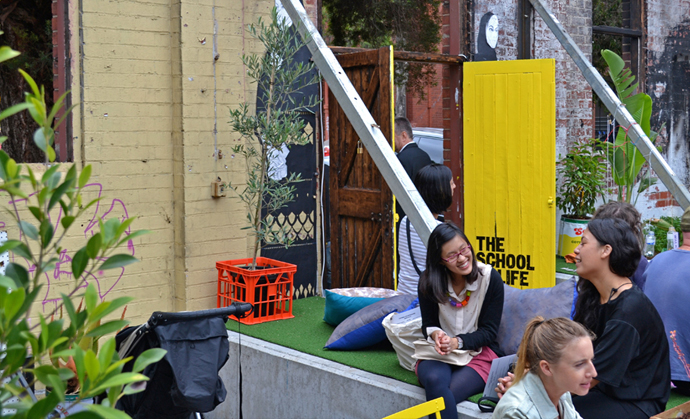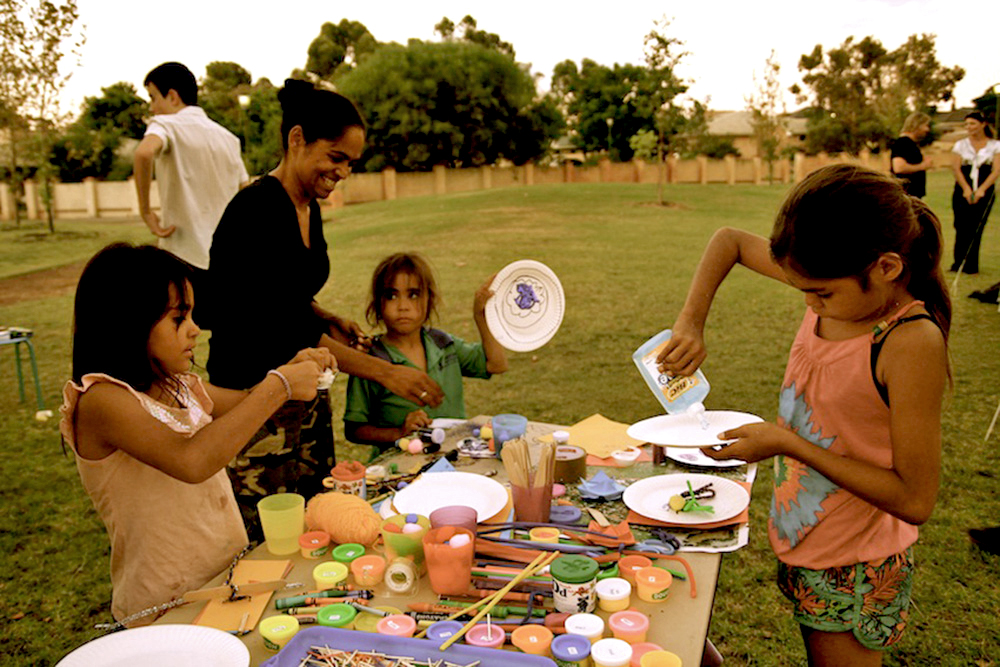Lucinda Hartley on building cities for citizens

After spending two years working in informal communities in Asia, Lucinda Hartley returned to Melbourne hungry to build upon the collaborative, community-driven design she had experienced in Vietnam and Cambodia. In 2010, she co-founded CoDesign Studio (with Hugh Adamson and Kate Ferguson), a cross-disciplinary design and placemaking social enterprise based in Collingwood, Melbourne. As CEO, Lucinda oversees the in-demand practice, working nationally with community groups, local councils, government agencies, developers and not-for-profits on a ‘horizontal’ approach to city making, in which the voice of the local resident is weighted equally with that of the bureaucratic top brass. Lucinda is also an elected representative to the UN-Habitat Youth Advisory Board, a Fellow of the Collaborative for Inclusive Urbanism and a member of the global Place Leadership Council. Eugenia Lim finds a quiet moment to chat with Lucinda after a bustling communal lunch at CoDesign HQ.

Eugenia Lim
You trained as a landscape architect at a time before the advent of ‘tactical urbanism’. When did you shift focus from designing for permanence towards more temporary or collaborative projects?
Lucinda Hartley
Tactical urbanism is an interesting term because for me, it describes the process of city making that people did before we ‘formalised’ things. Lately, there’s almost been a reinvention and going back to the roots of more collaborative city making. I think tactical urbanism is a tool – one of many – and the one I’m interested in at the moment, the one I’ll always be interested in. What draws me to it is it’s a participatory approach to city making. The limitation that I found with landscape architecture in its traditional sense is that it’s a very top down approach – the designer with a big idea, sometimes imposing it on a place that’s based on very good, proven best practices, but not necessarily responsive to that local identity or what that community wants. So I guess I became interested in community development and spent several years in Southeast Asia exploring that. To me, tactical urbanism is a great nexus of community development and design: by doing these short-term, low cost projects, you lower the barriers to entry, allowing a lot more people than in traditional design processes to have a decision in shaping their neighbourhood.

ELWorking in the developing world, did you observe a disconnection between the everyday person and community decision-making?
LHIt’s an interesting question because I actually observed the opposite. In informal settlements, people are very disconnected from their government, I mean completely. They certainly have no rights, no land, no education. But in terms of neighbourhood-building, maybe with the absence of rules… people wouldn’t hesitate to take over the pavement or open up a restaurant, or renovate their house or get together and build something for their community. People were doing that all the time and I was actually quite inspired because I didn’t see that happening here. Here we always think, ‘it’s someone else’s problem’ and ‘I pay my rates so why don’t they fix it’… and you’re like ‘well, maybe you can fix it’! But also, I think our council systems don’t really allow us to take responsibility, so it’s a bit of a double-edged sword.
ELIn the tactical urbanism guide you authored (which focuses on Australian and New Zealand projects), you identify a local government-sanctioned approach to urbanism, and suggest that maybe we could do with more grass roots projects. What would you like to see?
LHI think perhaps, in an ideal world, there could be a limit on the important and central function of government – then citizens could have more of a role in shaping their neighbourhoods. Look at our grandparent’s generation – they built schools, they built churches, there are streets named after them – they were actively contributing to their neighbourhood. No one does that anymore. Some council areas even dictate the colour of your front fence. I think that’s going too far… what I’d like to see is a greater sense of citizen ownership. That sense of ownership comes through creating something together. I think people are really craving that old-fashioned sense of neighbourhood, where you actually knew your neighbours and you’d go next door for a cup of sugar. I don’t think that we can nostalgically look back to that time because life is so different now, but I think we can get more involved in shaping our physical environments. So I guess I would like to see more grass roots guerilla activity, at a certain level. But I would also like to see our local governments thriving and providing public transport and roads and services in the way that they should be.
ELThe horizontal, non-hierarchical approach you write about is interesting. We often do just sit back and wait for things to change, but then nothing changes!
LHOr we fight against something when we could be more collaborative.



ELIs there a current project you’re working on, as a kind of case study of this approach?
LHI’ll share two. Last year, we worked on a laneway revitalisation project in Brunswick. Melbourne has 64km of bluestone laneways, the largest network in the world. They were under threat from being concreted over – they’re quite run down, over a hundred years old – but two years ago, a community group called ‘Save the Brunswick Bluestone Laneways Resident’s Group’ (the name wasn’t too catchy, we renamed it the ‘Bluestone Collective’!) managed to save the laneways. Which is a good first step, but [the laneways] are still really rundown and there’s a perception that they’re unsafe, with illegal dumping and various other things. The good thing about laneways is that they’re all quite small, with thirty to forty residents living on one – a nice neighbourhood block to work with. So we worked with some of the residents of one of the laneways, then all of the residents eventually, to upgrade this laneway in a weekend. It began as a safety project – let’s clean this place up and make it look a bit safer. Then, as we started that conversation with residents and as they got to know each other, they started thinking, ‘well, my friend’s an artist, maybe they could paint that wall’, and someone else said, ‘well, I own a vacant lot and it abuts this laneway… why don’t we take the fence down and turn it into a community garden’? And then the youth centre up the road said, ‘great, we’ll come and maintain it and use it as part of our programs’ and someone else said they’d make a film about it. All these really great things that people could get involved with. In the first instance, it was a Department of Justice project purely focused on clean up and safety. But the long-term outcome is that these guys all got to know each other, and they regularly have dinners in the laneway now, once a month. This small catalyst has created a new neighbourhood relationship.


Then, in other ways, that same kind of scenario can be created when initiated by a government agency. So we’re working with City of Melbourne on a programme that turns redundant road space into temporary play space. So in densely populated areas, every Sunday afternoon, certain streets will be closed for play, for example. That has begun as a government initiative, about increasing physical activity and social connection, but the aim is to use this as a catalyst that will get the residents together so that they will sustain and maintain the project. And the plan is, if you’ve got a bunch of residents in another street somewhere else, they’ll be able to run a play street in the future too. I think it’s possible for government to lead, as well as residents.

ELOn a global front, I re-watched your TED talk and you compare two divergent city typologies. On the one hand, we’ve got the hyper-futuristic Masdar City in the United Arab Emirates; and on the other, Kibera, Africa’s largest slum. If our urban reality is going to look much more like Kibera, what should we be doing to prepare? What should we be putting in place?
LHThe reality on a global scale is that cities are expanding by a million people a week. That’s the equivalent of one Copenhagen every week, so we actually can’t keep up. Even if we wanted to, we can’t. So to me, the only option that we have is to enable everyday citizens to be city makers. If we start to create the frameworks that support people to shape their own environment, then we’ve got a chance. There are still some things that should absolutely be centrally managed – roads, water supply public transport – but beyond that, if we try and control everything, we won’t be able to make it. But we have some chance of creating liveable communities if governments focus on the ‘big’ stuff and let communities focus on the ‘small’ stuff. And it’ll be haphazard and it won’t necessarily be best practice, but it’ll be beautiful in the sense that it’ll be localised. Each place will have its own identity.

ELIs it that residents or communities know what they most want or need?
LHYeah, even if [the community] builds something that turns out to be different to their initial ideal, at least it has a certain character or identity. An expression that is difficult for someone outside to create.
ELYou can’t really impose character on a neighbourhood.
LHBut we try [laughs]! That’s definitely true.
ELWhat really comes through in your TED talk is that perhaps we need to fundamentally question the notion of ‘liveability’. Last year, the Economist ranked Melbourne the world’s most liveable city for the fourth time in a row. What are your thoughts on that and what it means in a global context?
LHYeah, there are differing definitions of what ‘liveable’ really means. In Melbourne, the inner 10km radius is ‘liveable’, but what about the next 30km? In fact, two thirds of the population lives in the not-so-liveable Melbourne – a big divide that’s widening.
In Melbourne, it’s a mix of both a hardware and software problem. I think when inner Melbourne was developed, it was made by people like our grandparents who built their own homes and schools, creating a dense and diverse urban fabric, which makes it much more adaptable to changing culture. The problem with over-planning the outer and even the middle ring is that it’s so planned that it’s only planned for a single use. As culture changes, it can’t adapt. And that’s a real challenge – in thirty, forty years time, what kind of places are we going to have? So there’s a major hardware problem, in the sense that we actually need more density, better public infrastructure. On a neighbourhood level, we could still be giving emerging communities much more of an identity by not controlling everything that goes in. I mean, there are usually only ten different housing types that people can choose from, so it creates a very homogenous environment within a homogenous income bracket. You don’t see that so much in the inner areas because they evolve differently. So I think you could actually change the way that people control their environment to possibly create more diversity.
On a global level, the macroeconomics of the rich getting richer and the poor getting poorer are massive challenges. I think in terms of urban planning though, the failure is that we tend to look at the mistakes and findings from Western cities and try and apply them elsewhere. Equally I think many developing nations look to planning theory from Western cities to dictate how their cities will grow, but this is based on a certain cultural pattern of European and North American cities that may not apply to the way that people relate to each other, in say the Middle East or Africa. So I think this all needs to happen very quickly, but with almost a new typology of city that allows for slums – because this is our shared reality. But also, cities must allow for different cultural expressions, in which highways and town centres may not be the answer.


ELYou work with a wide range of stakeholders: local government, non-profits, developers and the local community. How do you balance all of these potentially competing interests?
LHTo varying degrees of success. I always think projects are more authentic if they originate from a community and [CoDesign are] involved with connecting them ‘upwards’… down and up’s not quite the right analogy. But yeah, it’s a real challenge. I think at the macro level, the interests are often the same. Developers often genuinely want to create good places to live – their brand reputation depends on it.
ELDo you think developers are getting savvy to the concept of promoting ongoing social cohesion?
LHYes, definitely. I think the leading players in Australia are doing some quite interesting work actually. The notion of the big bad developer is a bit of an old notion, there’s still probably a long way to go, but the leading major players are really quite innovative in their approach to placemaking and quite sophisticated in their understanding of what will create a great space. I’ve been quite impressed with the sophistication of some of their approaches and their interest in creating generally socially cohesive places.
We spend a lot of time just trying to understand different groups, stakeholders. Listening and working out the common goal. When we’re all working towards the same thing, it becomes much easier.
ELWhere would you most like to do a CoDesign project?
LHWe aim to bring people together and improve social connection. The places that we would most like to work at the moment are where new communities are emerging, where this need is greatest. This means outer greenfield areas, and urban infill suburbs like Fisherman’s Bend.
ELWhat makes a city good?
LHCities are good when people feel safe and healthy and have a lot of freedom to make choices about their life. Because opportunities come when people are involved in owning and shaping their neighbourhoods. I think we have a lot of freedoms in Australia, yet I think we could have greater freedoms in some forms of decision-making about our neighbourhoods. And I do genuinely think you get a much greater sense of civic pride, involvement and commitment when people are actually leading the decision-making and not being told what to do.
Many thanks to Lucinda Hartley and the CoDesign team. To learn more about CoDesign’s work, visit: codesignstudio.com.au. You can practice your own tactical urbanism or rapidly revitalise your own neighbourhood with the guidance of CoDesign’s free publications.

